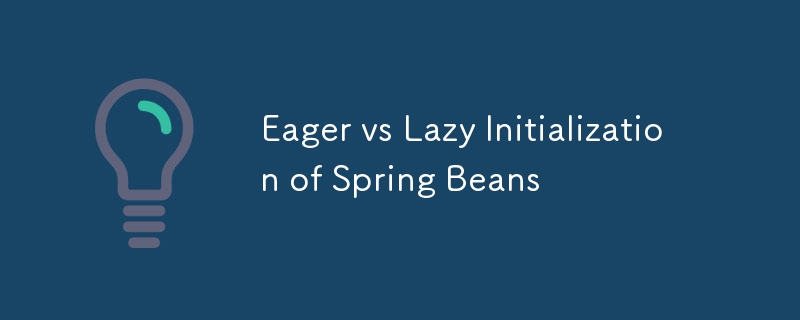Spring Bean 的急切初始化与延迟初始化
- 王林原创
- 2024-08-27 20:00:50845浏览

在 Spring 中,基本概念之一围绕着 beans 的初始化。使用 Spring 框架开发应用程序时,您可以选择 bean 的 eager 和 lazy 初始化。两者都有其独特的优势和权衡,了解这些差异可以帮助您优化应用程序的性能和资源使用。
什么是春豆?
在深入探讨急切初始化和惰性初始化之前,让我们简单介绍一下 Spring bean 是什么。在 Spring 中,bean 只是一个由 Spring IoC(控制反转)容器实例化、组装和管理的对象。默认情况下,Bean 通常是单例的(尽管可以更改),并且代表 Spring 应用程序的核心构建块。
热切初始化
什么是热切初始化?
急切初始化是 Spring 中的默认行为。当Spring的ApplicationContext被创建时,它会急切地实例化配置中定义的所有bean。这意味着一旦 Spring 上下文完全加载,所有单例 bean 就会被创建并注入它们的依赖项。
例子
考虑以下示例:
@Configuration
public class AppConfig {
@Bean
public ServiceA serviceA() {
return new ServiceA();
}
@Bean
public ServiceB serviceB() {
return new ServiceB();
}
}
在上面的代码中,一旦ApplicationContext初始化,ServiceA和ServiceB都会被实例化。这是热切初始化的实际应用。
热切初始化的优点
早期故障检测:由于所有 bean 都是在启动时实例化的,因此任何问题(例如配置错误、缺少依赖项或 bean 创建失败)都会立即检测到。这使得在开发过程中更容易识别和解决问题。
-
可预测的启动行为:通过急切初始化,启动过程是可预测的,因为所有 bean 都是提前创建的,确保它们在应用程序启动后立即可供使用。
急切初始化的缺点
增加启动时间:如果您的应用程序有许多 Bean 和依赖项,急切初始化会增加应用程序的启动时间,因为所有 Bean 都会立即创建,无论它们是否立即需要.
内存使用:急切的初始化可能会导致更高的内存消耗,特别是对于不立即使用的bean。应用程序上下文初始化后,所有 Bean 都会占用内存,这在某些情况下可能会造成浪费。
延迟初始化
什么是延迟初始化?
延迟初始化,顾名思义,推迟 Bean 的创建,直到应用程序首次请求它们。这意味着一个 bean 仅在被另一个 bean 或应用程序逻辑访问时才会被实例化。
在 Spring 中,可以通过使用 @Lazy 注解单个 bean 或为所有 bean 全局设置延迟初始化来启用延迟初始化。
例子
以下是实现延迟初始化的方法:
@Configuration
public class AppConfig {
@Bean
@Lazy
public ServiceA serviceA() {
return new ServiceA();
}
@Bean
public ServiceB serviceB() {
return new ServiceB();
}
}
在此示例中,ServiceA 在首次访问之前不会被实例化,而 ServiceB 将像平常一样急切地初始化。
延迟初始化的优点
减少启动时间:由于 Bean 仅在需要时才实例化,因此可以显着减少应用程序的启动时间,特别是在具有许多 Bean 或复杂初始化逻辑的应用程序中。
-
内存效率:不立即使用的 Bean 不会消耗内存资源,这在资源受限的环境中或某些 Bean 仅在极少数情况下使用时非常有用。
延迟初始化的缺点
延迟故障检测:如果延迟初始化 bean 的配置或创建存在问题,则在首次访问该 bean 之前不会检测到这些问题。这会延迟问题的发现并使调试变得更加困难。
运行时期间的意外延迟:由于惰性 bean 是在首次使用时实例化的,因此对 bean 的第一个请求可能会在应用程序中引入延迟,特别是在初始化过程复杂或耗时的情况下-消耗。
全局延迟初始化
在 Spring Boot 中,您可以通过在 application.properties 或 application.yml 文件中添加以下属性来全局启用延迟初始化:
spring.main.lazy-initialization=true
When this is set, all beans in the application will be lazily initialized by default. This approach can be useful for applications with large numbers of beans that are not required immediately at startup.
When to Use Eager vs Lazy Initialization?
Eager Initialization
Applications with Predictable Startup Requirements: If your application relies on having all beans ready immediately after startup and you want to detect configuration issues as early as possible, eager initialization is the better choice.
Small Applications: For small to medium-sized applications with a limited number of beans, the overhead of eager initialization is negligible, making it a more straightforward and predictable option.
Lazy Initialization
Large Applications with Many Beans: In large applications where certain beans are rarely or never used in specific environments (e.g., certain beans are only needed for particular jobs or services), lazy initialization can optimize memory usage and improve startup times.
Performance-Sensitive Applications: If reducing startup time is a priority (for instance, in microservices where instances are frequently restarted), lazy initialization can be helpful in spreading the bean initialization load over time.
Conditional Use: If some beans are only used under specific conditions, lazy initialization can prevent unnecessary instantiation of those beans.
Wrapping up
Choosing between eager and lazy initialization depends on your application’s needs. Eager initialization is beneficial for catching issues early and ensuring that all beans are ready immediately after startup. Lazy initialization, on the other hand, can optimize startup time and memory usage, but it may delay the detection of bean-related issues until the bean is first accessed.
By carefully considering the trade-offs, you can choose the right strategy or even mix both approaches to suit your application's specific requirements. Whether you choose eager or lazy initialization, understanding these concepts will help you optimize your Spring application and ensure that it behaves efficiently and predictably.
以上是Spring Bean 的急切初始化与延迟初始化的详细内容。更多信息请关注PHP中文网其他相关文章!

